On Saturday, Nov. 5, the Archdiocese of Milwaukee swings open the doors to four parishes around Milwaukee to welcome the community in for behind the scenes tours and more. We're writing about all four parishes before the event.
Today, we visit Bay View’s Immaculate Conception.
Like any building, a church can change over time. Typically, a small church gets replaced or enlarged. Often in Milwaukee, as neighborhood demographics change, older churches can close and their buildings may re-open as home to a new congregation.
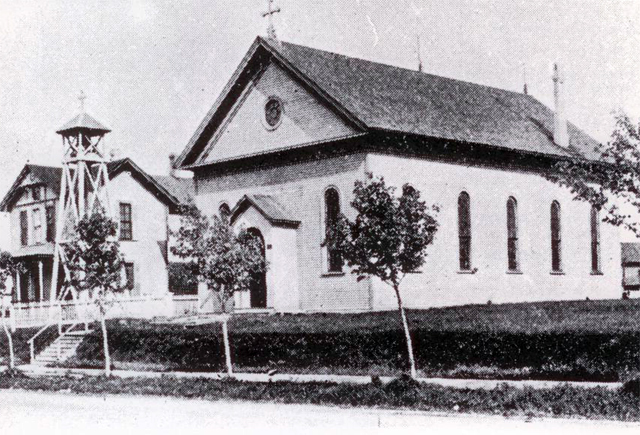
(PHOTO: Courtesy of Immaculate Conception)
Bay View’s Immaculate Conception, 1023 E. Russell Ave., is so long-lived that it’s seen a number of changes. Its original church (pictured above) was replaced by the current building in 1907 and its early school – dating to the birth of the parish 1885 (pictured below) – still stands, but has gotten a number of additions.

In 1958, the church was enlarged with a new lobby and porch on the south end, and it was at this time that something a little more unusual occurred at this originally heavily-Irish parish.
Perhaps conjuring that famous verse from the Gospel of Matthew that says the first shall be last and the last shall be first, Immaculate Conception’s front became its back and its back became its front.

(PHOTO: Courtesy of Immaculate Conception)
The origins of the parish date back to 1870 when Bishop John Martin Henni decided that Bay View needed a Catholic church for the many faithful who worked at the rolling mills along the lake.
The mill owners donated three lots on the southeast corner of Russell and Kinnickinnic, and Bay Viewers began to raise funds for the small wooden church that was ultimately erected there in November 1871. The parish was officially incorporated in 1885, and the school was built.
In 1907, the current church was erected to designs by architects Buemming & Dick. And the congregation continued to balloon, leading to the expansion in 1958 (pictured above), with plans drawn by Brust & Brust. A large new school building was added eight years earlier.
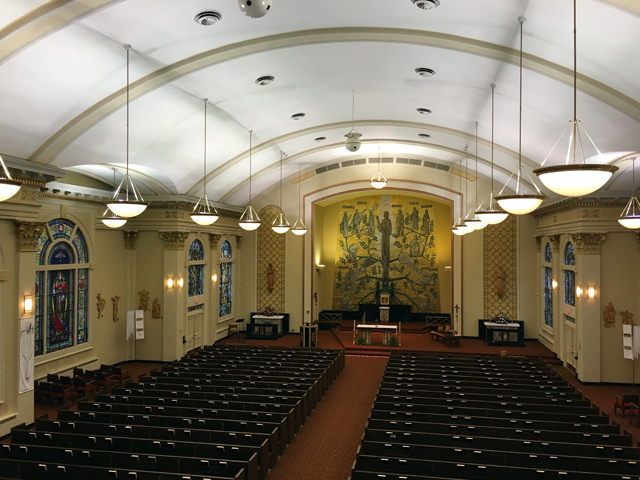
A book published by the congregation on the occasion of the remodeling explained the rationale for flipping the orientation of the sanctuary:
"The answer lies in the fact that a better solution to accomplish the needs for greater capacity of people, to provide better heating and ventilation, to provide a Mothers’ room, a cloak room, a more convenient entrance, could not be found.
"Actually many preliminary studies were made ... More serious thought was given to the development of a new church. ... A most natural thought was this: Why not move the Sanctuary some distance further south? The necessity of excavations near the front of the Church would have endangered the tower. Moreover, placing the rear of the new Church on a prominent street, South K.K., seemed out of order. The advantages of the entrance on the higher street, K.K. Ave., permits entrance to Church without exterior steps, provides a main face of the building on the main street, places the main entry near the parking lot, and also located the sacristy near the rectory where an easy juncture was developed. Many variations of this finally selected scheme were studied until the present plan was approved by all concerned."
At the same time, the church installed the large mural behind the new altar and stained glass windows designed by Felix Senger and executed by Conrad Schmitt Studios.
Recently, I got a tour of the church from Rev. Philip J. Schumaker, who is also pastor at St. Augustine of Hippo Parish over on Howell Avenue.
Luckily for me, the young and energetic Schumaker is as nosy as I am, because in addition to showing me the sanctuary, choir loft, rectory and church basement where the church’s long-running dartball league still plays, he was eager and ready to go on a climb up into the tower.
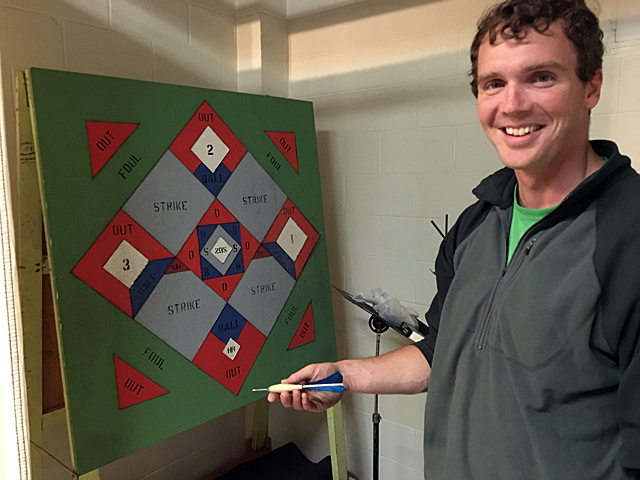
Even though I’ve been up into a fair few of these towers by now, the one at IC is fairly challenging.
A metal spiral staircase leads up into a space that was part of the choir loft when the front was the back and the back was the front and then a half-dozen narrow wooden steps take you into a tight space that is the base of the tower.
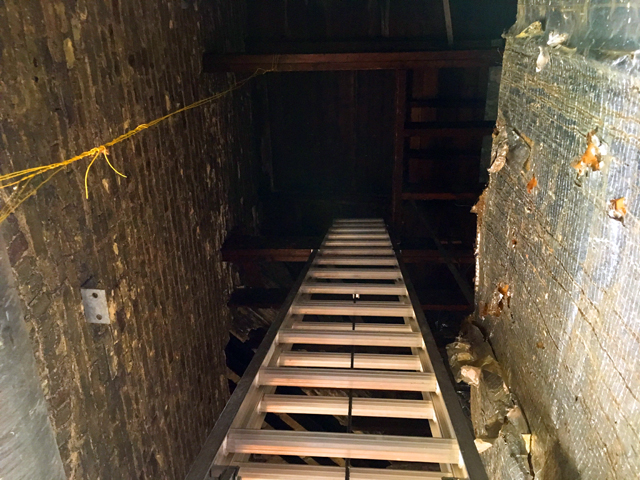
In here, you’re cheek to jowl with the air handlers and other HVAC equipment. There’s also an opening that leads to the catwalk above the ceiling of the sanctuary. This is often the only way for many churches to change light bulbs in their extremely high-ceilinged sanctuaries.
From here, it’s all ladders.
First, there’s a 20- to 25-foot metal ladder that leads up to a scuttle. It looks like a long way up. Worse still, it looks like a long way down when you’re going the other way. But, successfully scaled, one finds oneself in the middle portion of the tower – the part outside that’s got the pediment-capped pilasters.

Though the openings are screened to keep out the birds, the view of the neighborhood and even the Downtown skyline is pretty nice from here. The view up the next ladder, perhaps another 15-20 feet up to another scuttle hatch, is less alluring.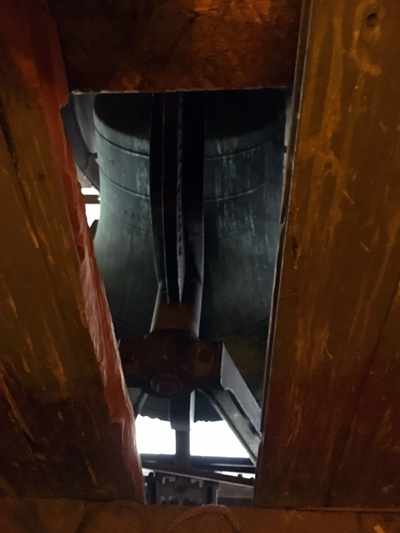
But still we climb and find ourselves in the base of the cupola, the windows of which have opaque yellow glass and give the area an eerie glow. In the center, we can see the bell, which is mostly encased in a wooden cube. Just above our heads are loose planks criss-crossed into an asterisk shape.
If we could position a ladder securely on them and climb another dozen or so feet, we could pull ourselves up through the hatch into the dome itself, but there’s no ladder long enough and consensus seems to be that it’d be a bad idea even if we had one.
So we shoot a few yellowy photos and begin the much more daunting task of returning from whence we came without looking down and freaking ourselves out. Father Philip has the considerably more daunting job – as the last one down – of figuring out how to steady himself at the top of that longest ladder while simultaneously dragging into place an extremely heavy wooden hatch cover.
 It’s fairly alarming to watch as he stands, facing outward on the ladder, resting the hatch on his head as he drags it over. More than one prayer is said, and Father Philip is safe and soon down on solid ground.
It’s fairly alarming to watch as he stands, facing outward on the ladder, resting the hatch on his head as he drags it over. More than one prayer is said, and Father Philip is safe and soon down on solid ground.
After this, he even gives in to the lowest-pressure push to recreate the journey at nearby St. Augustine, where the trip up is much, much easier, despite one very, very rickety wooden staircase that makes us all a little nervous, but gets the job done.
Stay tuned for more on St. Augustine in the future.
For now, check out Immaculate Conception during the VIP event. Even though there’s no way anyone is letting you near those ladders, there’s plenty of interest to see, including the lovely windows, a dartball demonstration and the flip-flopped sanctuary.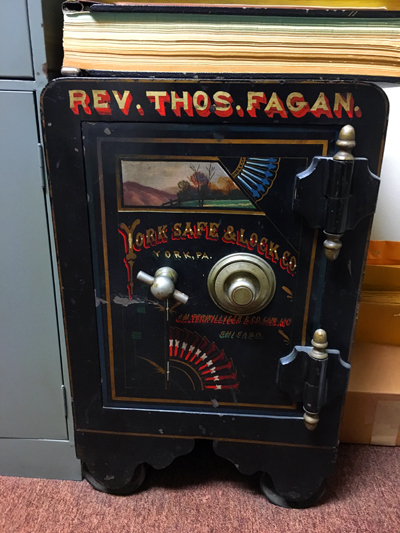
In the rectory, be sure to check out the safe that’s elaborately painted with the name of Father Fagan, who is a legendary character in Bay View and a key figure in the history of the parish.
Complete details of all four churches taking part in the VIP event are here.
Admission is free and all are welcome. A shuttle bus will run between all four churches during the event, so you can park (or walk) once and ride the bus.
In addition, Bryant's Cocktail Lounge, 1579 S. 9th St., will partner with IC during the event, offering its classic Old Fashioned cocktail at the special VIP price of $5, or the seasonal Otono for $6, from 3 to 5 p.m.
Read my stories about Saint Bernard Parish in Wauwatosa here, Our Lady of Guadalupe (Holy Trinity) here and All Saints here.
Born in Brooklyn, N.Y., where he lived until he was 17, Bobby received his BA-Mass Communications from UWM in 1989 and has lived in Walker's Point, Bay View, Enderis Park, South Milwaukee and on the East Side.
He has published three non-fiction books in Italy – including one about an event in Milwaukee history, which was published in the U.S. in autumn 2010. Four more books, all about Milwaukee, have been published by The History Press.
With his most recent band, The Yell Leaders, Bobby released four LPs and had a songs featured in episodes of TV's "Party of Five" and "Dawson's Creek," and films in Japan, South America and the U.S. The Yell Leaders were named the best unsigned band in their region by VH-1 as part of its Rock Across America 1998 Tour. Most recently, the band contributed tracks to a UK vinyl/CD tribute to the Redskins and collaborated on a track with Italian novelist Enrico Remmert.
He's produced three installments of the "OMCD" series of local music compilations for OnMilwaukee.com and in 2007 produced a CD of Italian music and poetry.
In 2005, he was awarded the City of Asti's (Italy) Journalism Prize for his work focusing on that area. He has also won awards from the Milwaukee Press Club.
He has be heard on 88Nine Radio Milwaukee talking about his "Urban Spelunking" series of stories, in that station's most popular podcast.







